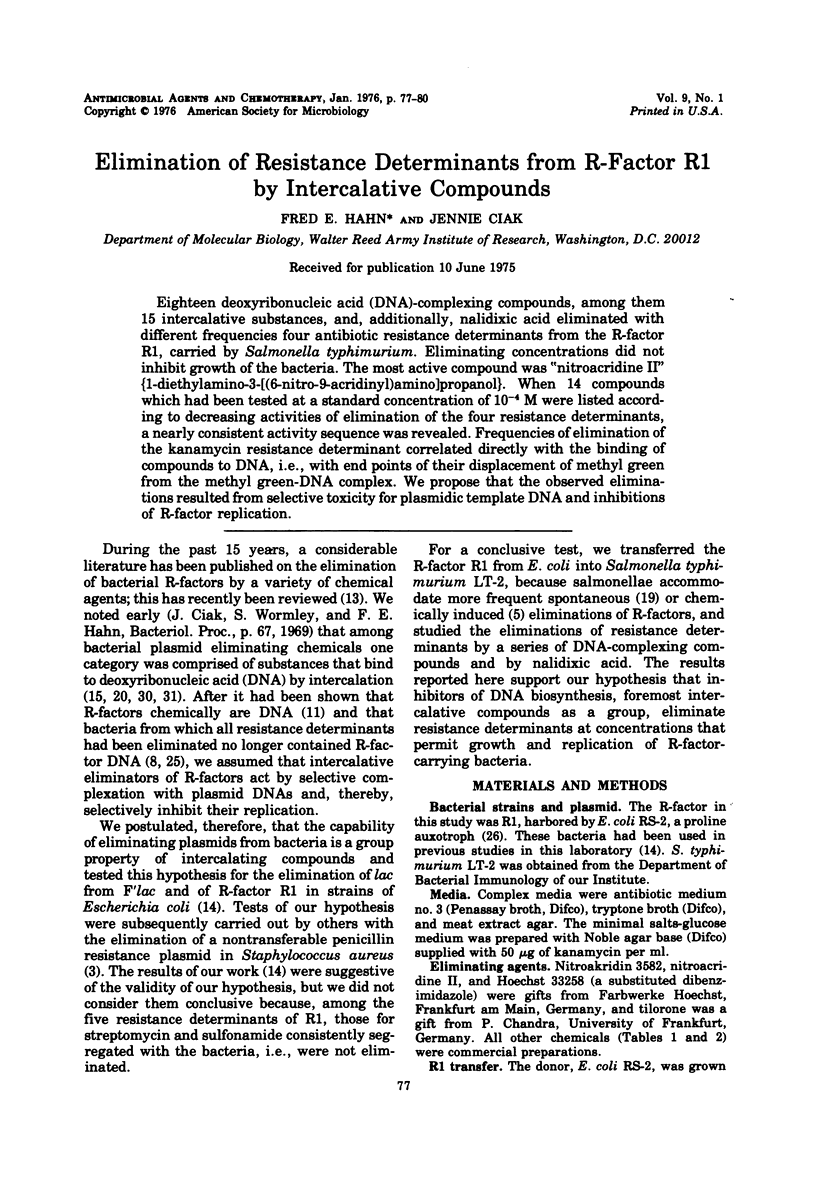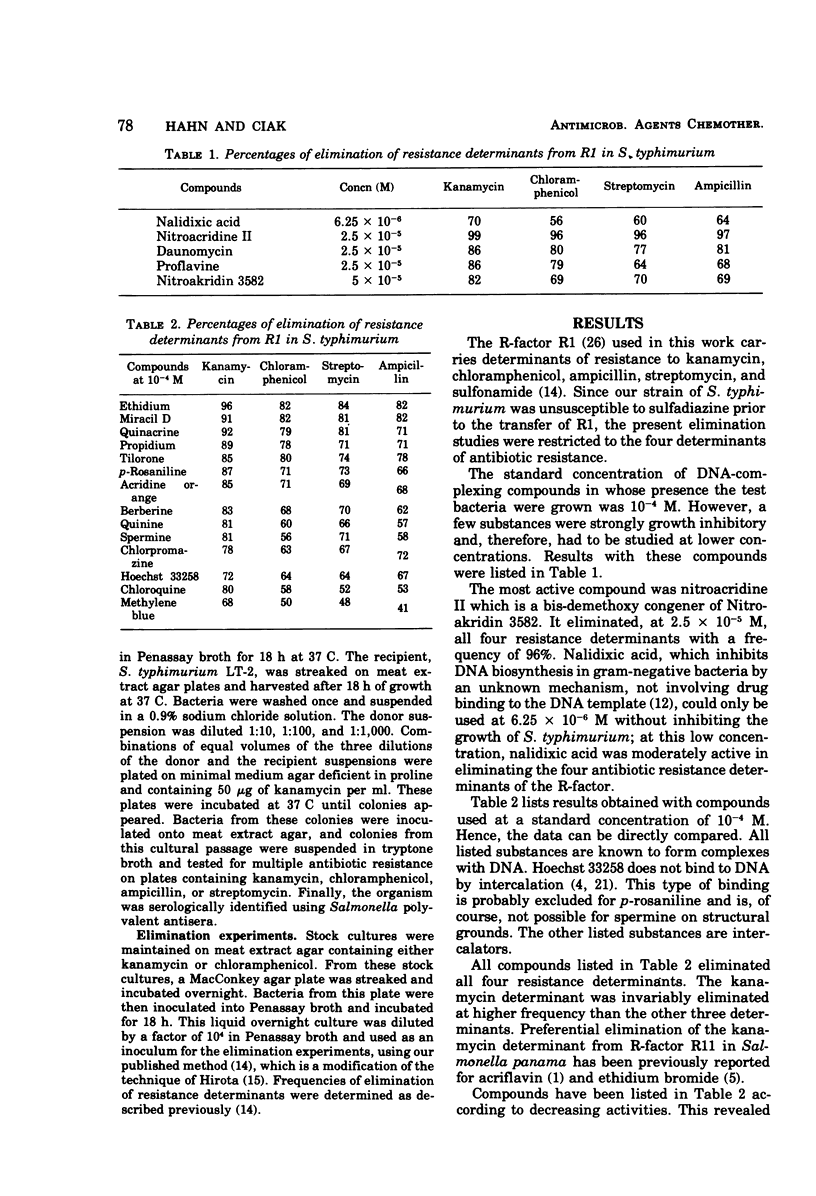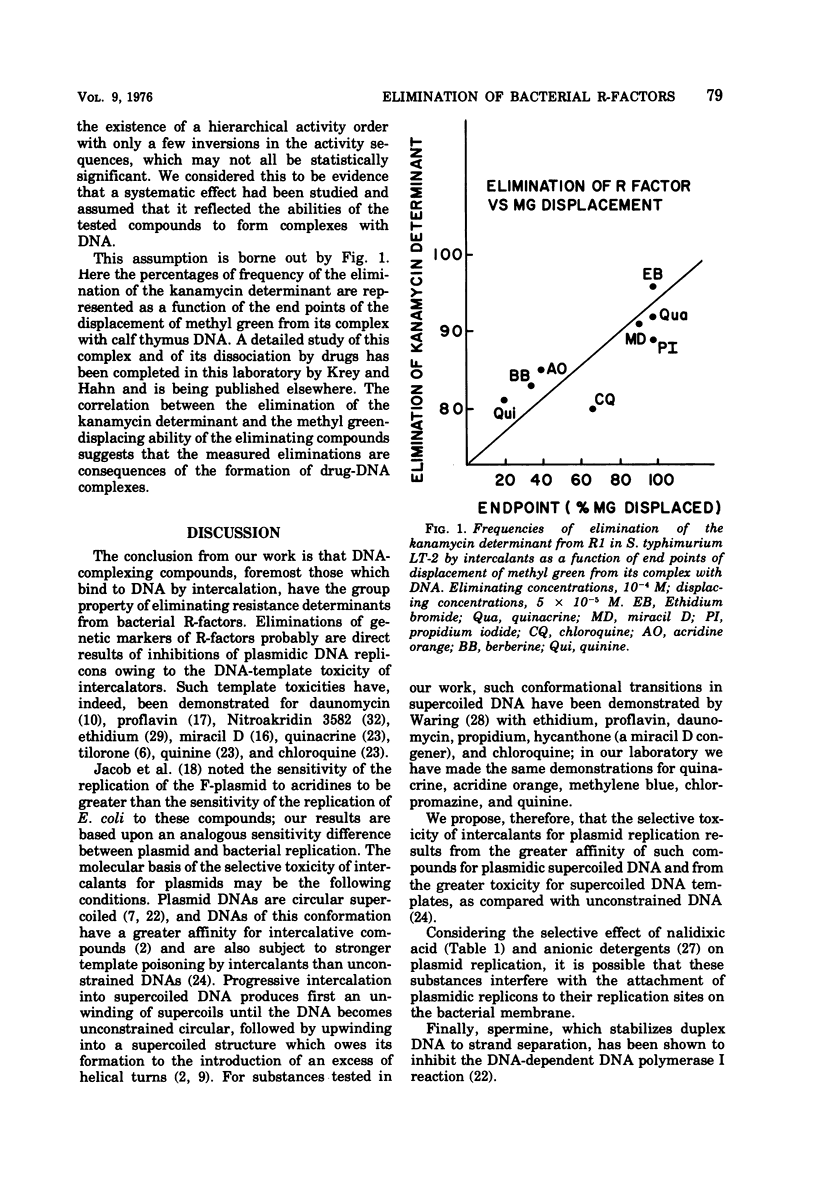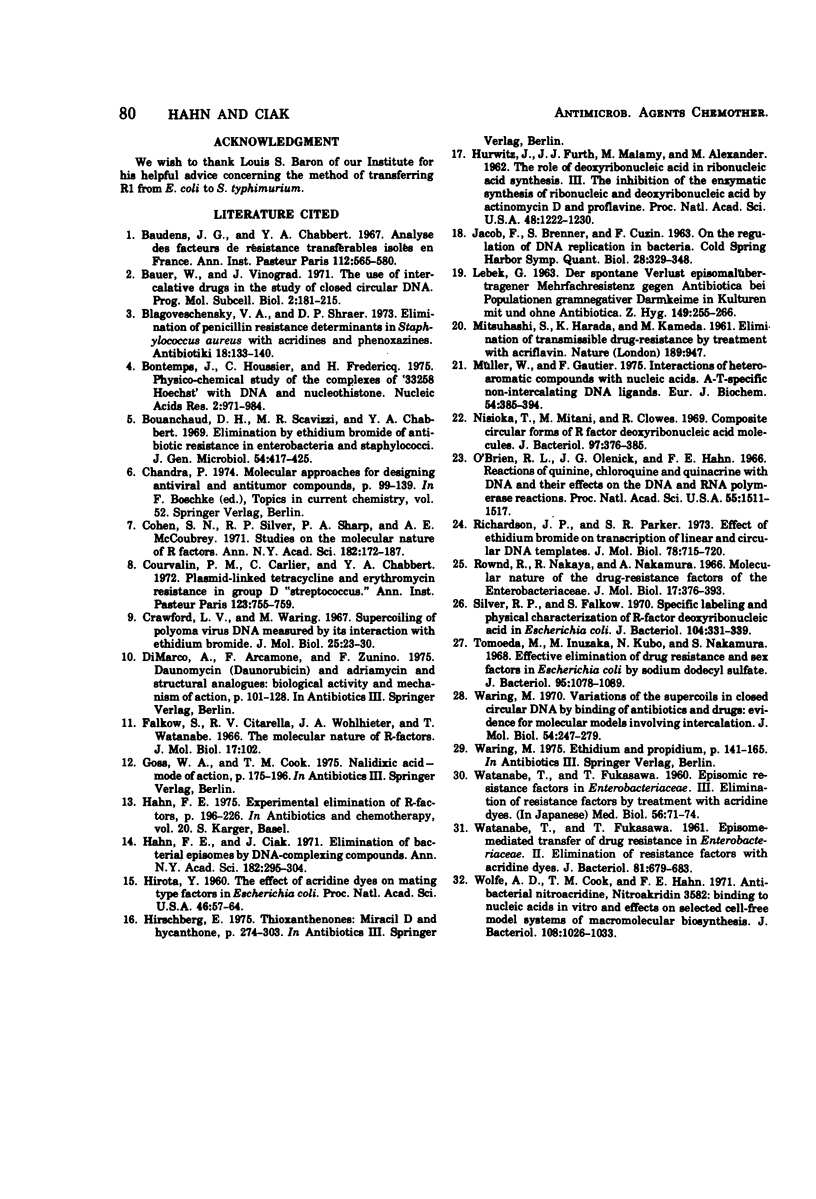Abstract
Eighteen deoxyribonucleic acid (DNA)-complexing compounds, among them 15 intercalative substances, and, additionally, nalidixic acid eliminated with different frequencies four antibiotic resistance determinants from the R-factor R1, carried by Salmonella typhimurium. Eliminating concentrations did not inhibit growth of the bacteria. The most active compound was “nitroacridine II” {1-diethylamino-3-[(6-nitro-9-acridinyl)amino]propanol}. When 14 compounds which had been tested at a standard concentration of 10−4 M were listed according to decreasing activities of elimination of the four resistance determinants, a nearly consistent activity sequence was revealed. Frequencies of elimination of the kanamycin resistance determinant correlated directly with the binding of compounds to DNA, i.e., with end points of their displacement of methyl green from the methyl green-DNA complex. We propose that the observed eliminations resulted from selective toxicity for plasmidic template DNA and inhibitions of R-factor replication.
Full text
PDF



Selected References
These references are in PubMed. This may not be the complete list of references from this article.
- Baudens J. G., Chabbert Y. A. Analyse des facteurs de résistance transférables isolés en France. Ann Inst Pasteur (Paris) 1967 May;112(5):565–580. [PubMed] [Google Scholar]
- Blagoveschenskii V. A., Shraer D. P. Eliminirovanie determinantov penitsillinoustoichivosti u zolotistogo stafilokokka akridinemi i fenoksazinami. Antibiotiki. 1973 Feb;18(2):133–140. [PubMed] [Google Scholar]
- Bontemps J., Houssier C., Fredericq E. Physico-chemical study of the complexes of "33258 Hoechst" with DNA and nucleohistone. Nucleic Acids Res. 1975 Jun;2(6):971–984. doi: 10.1093/nar/2.6.971. [DOI] [PMC free article] [PubMed] [Google Scholar]
- Bouanchaud D. H., Scavizzi M. R., Chabbert Y. A. Elimination by ethidium bromide of antibiotic resistance in enterobacteria and staphylococci. J Gen Microbiol. 1968 Dec;54(3):417–425. doi: 10.1099/00221287-54-3-417. [DOI] [PubMed] [Google Scholar]
- Chandra P. Molecular approaches for designing antiviral and antitumor compounds. Top Curr Chem. 1974;52:99–139. doi: 10.1007/3-540-06873-2_15. [DOI] [PubMed] [Google Scholar]
- Cohen S. N., Silver R. P., Sharp P. A., McCoubrey A. E. The problems of drug-resistant pathogenic bacteria. Studies on the molecular nature of R factors. Ann N Y Acad Sci. 1971 Jun 11;182:172–187. doi: 10.1111/j.1749-6632.1971.tb30655.x. [DOI] [PubMed] [Google Scholar]
- Courvalin P. M., Carlier C., Chabbert Y. A. Plasmid-linked tetracycline and erythromycin resistance in group D "streptococcus". Ann Inst Pasteur (Paris) 1972 Dec;123(6):755–759. [PubMed] [Google Scholar]
- Crawford L. V., Waring M. J. Supercoiling of polyoma virus DNA measured by its interaction with ethidium bromide. J Mol Biol. 1967 Apr 14;25(1):23–30. doi: 10.1016/0022-2836(67)90276-8. [DOI] [PubMed] [Google Scholar]
- Falkow S., Citarella R. V., Wohlhieter J. A. The molecular nature of R-factors. J Mol Biol. 1966 May;17(1):102–116. doi: 10.1016/s0022-2836(66)80097-9. [DOI] [PubMed] [Google Scholar]
- HURWITZ J., FURTH J. J., MALAMY M., ALEXANDER M. The role of deoxyribonucleic acid in ribonucleic acid synthesis. III. The inhibition of the enzymatic synthesis of ribonucleic acid and deoxyribonucleic acid by actinomycin D and proflavin. Proc Natl Acad Sci U S A. 1962 Jul 15;48:1222–1230. doi: 10.1073/pnas.48.7.1222. [DOI] [PMC free article] [PubMed] [Google Scholar]
- Hahn F. E., Ciak J. The problems of drug-resistant pathogenic bacteria. Elimination of bacterial episomes by DNA-complexing compounds. Ann N Y Acad Sci. 1971 Jun 11;182:295–304. doi: 10.1111/j.1749-6632.1971.tb30665.x. [DOI] [PubMed] [Google Scholar]
- Hahn F. E. Experimental elimination of R factors. Antibiot Chemother (1971) 1975;20:196–226. doi: 10.1159/000398468. [DOI] [PubMed] [Google Scholar]
- Hirota Y. THE EFFECT OF ACRIDINE DYES ON MATING TYPE FACTORS IN ESCHERICHIA COLI. Proc Natl Acad Sci U S A. 1960 Jan;46(1):57–64. doi: 10.1073/pnas.46.1.57. [DOI] [PMC free article] [PubMed] [Google Scholar]
- LEBEK G. DER SPONTANE VERLUST EPISOMAL UEBERTRAGENER MEHRFACHRESISTENZ GEGEN ANTIBIOTICA BEI POPULATIONEN GRAMNEGATIVER DARMKEIME IN KULTUREN MIT UND OHNE ANTIBIOTICA. Z Hyg Infektionskr. 1963 Oct 25;149:255–266. [PubMed] [Google Scholar]
- MITSUHASHI S., HARADA K., KAMEDA M. Elimination of transmissible drug-resistance by treatment with acriflavin. Nature. 1961 Mar 18;189:947–947. doi: 10.1038/189947a0. [DOI] [PubMed] [Google Scholar]
- Müller W., Gautier F. Interactions of heteroaromatic compounds with nucleic acids. A - T-specific non-intercalating DNA ligands. Eur J Biochem. 1975 Jun;54(2):385–394. doi: 10.1111/j.1432-1033.1975.tb04149.x. [DOI] [PubMed] [Google Scholar]
- Nisioka T., Mitani M., Clowes R. Composite circular forms of R factor deoxyribonucleic acid molecules. J Bacteriol. 1969 Jan;97(1):376–385. doi: 10.1128/jb.97.1.376-385.1969. [DOI] [PMC free article] [PubMed] [Google Scholar]
- O'Brien R. L., Olenick J. G., Hahn F. E. Reactions of quinine, chloroquine, and quinacrine with DNA and their effects on the DNA and RNA polymerase reactions. Proc Natl Acad Sci U S A. 1966 Jun;55(6):1511–1517. doi: 10.1073/pnas.55.6.1511. [DOI] [PMC free article] [PubMed] [Google Scholar]
- Richardson J. P., Parker S. R. Letter: Effect of ethidium bromide on transcription of linear and circular DNA templates. J Mol Biol. 1973 Aug 25;78(4):715–720. doi: 10.1016/0022-2836(73)90291-x. [DOI] [PubMed] [Google Scholar]
- Rownd R., Nakaya R., Nakamura A. Molecular nature of the drug-resistance factors of the Enterobacteriaceae. J Mol Biol. 1966 Jun;17(2):376–393. doi: 10.1016/s0022-2836(66)80149-3. [DOI] [PubMed] [Google Scholar]
- Silver R. P., Falkow S. Specific labeling and physical characterization of R-factor deoxyribonucleic acid in Escherichia coli. J Bacteriol. 1970 Oct;104(1):331–339. doi: 10.1128/jb.104.1.331-339.1970. [DOI] [PMC free article] [PubMed] [Google Scholar]
- Tomoeda M., Inuzuka M., Kubo N., Nakamura S. Effective elimination of drug resistance and sex factors in Escherichia coli by sodium dodecyl sulfate. J Bacteriol. 1968 Mar;95(3):1078–1089. doi: 10.1128/jb.95.3.1078-1089.1968. [DOI] [PMC free article] [PubMed] [Google Scholar]
- WATANABE T., FUKASAWA T. Episome-mediated transfer of drug resistance in Enterobacteriaceae. II. Elimination of resistance factors with acridine dyes. J Bacteriol. 1961 May;81:679–683. doi: 10.1128/jb.81.5.679-683.1961. [DOI] [PMC free article] [PubMed] [Google Scholar]
- Waring M. Variation of the supercoils in closed circular DNA by binding of antibiotics and drugs: evidence for molecular models involving intercalation. J Mol Biol. 1970 Dec 14;54(2):247–279. doi: 10.1016/0022-2836(70)90429-8. [DOI] [PubMed] [Google Scholar]
- Wolfe A. D., Cook T. M., Hahn F. E. Antibacterial nitroacridine, Nitroakridin 3582: binding to nucleic acids in vitro and effects on selected cell-free model systems of macromolecular biosynthesis. J Bacteriol. 1971 Dec;108(3):1026–1033. doi: 10.1128/jb.108.3.1026-1033.1971. [DOI] [PMC free article] [PubMed] [Google Scholar]


